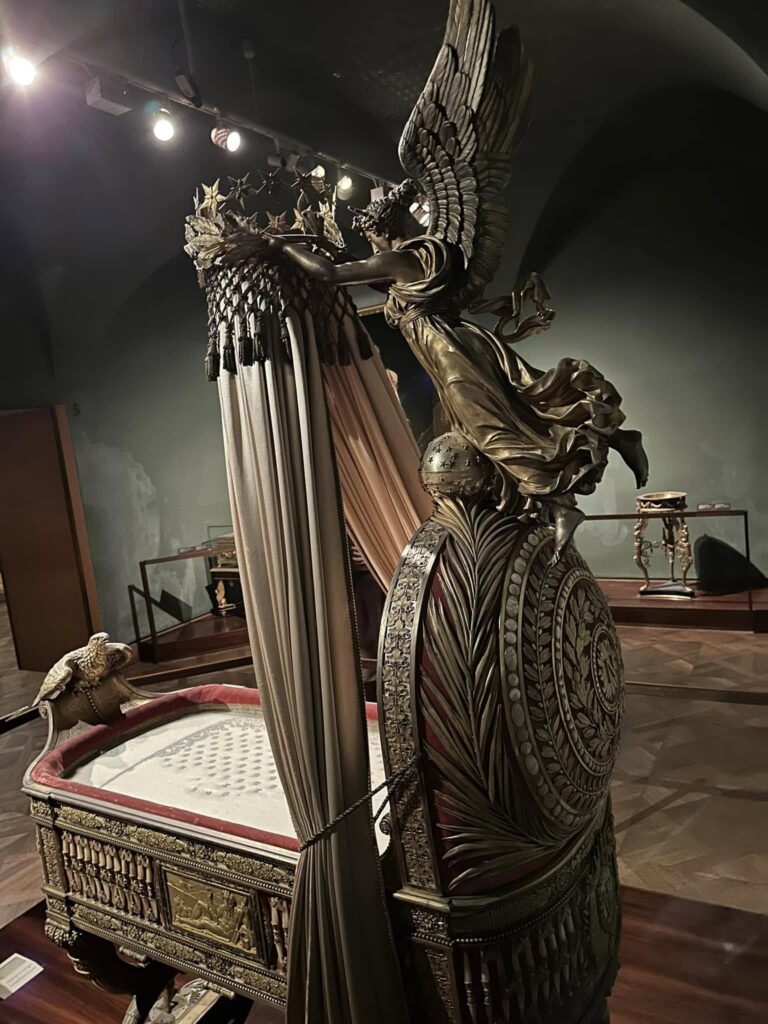1. The Historical Context of the King of Rome’s Birth
On March 20, 1811, Napoleon Bonaparte and his second wife, Marie Louise of Austria, celebrated the birth of their first son, Napoleon Franz Karl. This event was of immense political and symbolic importance, as it represented the continuation of Napoleon’s imperial dynasty. To mark the occasion, Napoleon conferred upon his newborn son the title of King of Rome, a designation steeped in the traditions of the Holy Roman Empire, symbolizing both power and legitimacy.
2. The Cradle: A Gift Fit for Royalty
The cradle, a gift from the city of Paris, was designed to embody the majesty and grandeur associated with the young prince’s title. Crafted in 1811, it was far more than a piece of furniture—it was a statement of power, wealth, and imperial ambition. Its elaborate design included gilded decorations, finely detailed carvings, and symbols of authority, making it as awe-inspiring as a royal throne.

3. Design and Symbolism
The cradle’s design was meticulously curated to reflect both the Napoleonic vision and the cultural ideals of the time:
- Gilded Decorations: The gold embellishments symbolized wealth, prosperity, and the eternal glory of the Napoleonic reign.
- Imperial Motifs: Symbols such as eagles, laurel wreaths, and bees were incorporated, representing victory, authority, and the unity of the empire.
- Ornate Craftsmanship: The cradle exemplified the finest artistry of the era, demonstrating the skill and dedication of its creators.
Every detail was intended to reinforce the significance of the King of Rome as a future ruler and a beacon of hope for Napoleon’s dynasty.

4. The Political Significance of the Cradle
The cradle was more than a gift—it was a political statement. By commissioning such a magnificent piece, the city of Paris sought to express loyalty and support for Napoleon’s regime. At the same time, the cradle’s design reinforced Napoleon’s vision of imperial continuity, as the birth of his son was seen as securing the stability of the empire.
The title of King of Rome itself carried weighty connotations. It evoked the legacy of the Holy Roman Empire, tying Napoleon’s rule to centuries of European history and signaling his ambition to establish a lasting dynasty.
5. The Cradle’s Legacy
Today, the cradle is preserved in the Kunsthistorisches Museum in Austria, where it stands as a symbol of the Napoleonic era’s opulence and its complex interplay of power, art, and politics. Visitors marvel at its craftsmanship, but it also serves as a poignant reminder of the fragility of Napoleon’s ambitions. Despite the grand aspirations symbolized by the cradle, the empire he sought to secure for his son crumbled within a few years.

6. A Reflection on Napoleonic Splendor
The cradle of the King of Rome remains one of the most iconic artifacts of the Napoleonic era. It encapsulates the height of Napoleon’s power and the optimism surrounding the birth of his heir. However, it also symbolizes the fleeting nature of imperial dreams, as Napoleon’s dynasty did not endure. Through its intricate design and rich symbolism, the cradle tells a story not only of a family but of an empire striving for eternal legacy.
